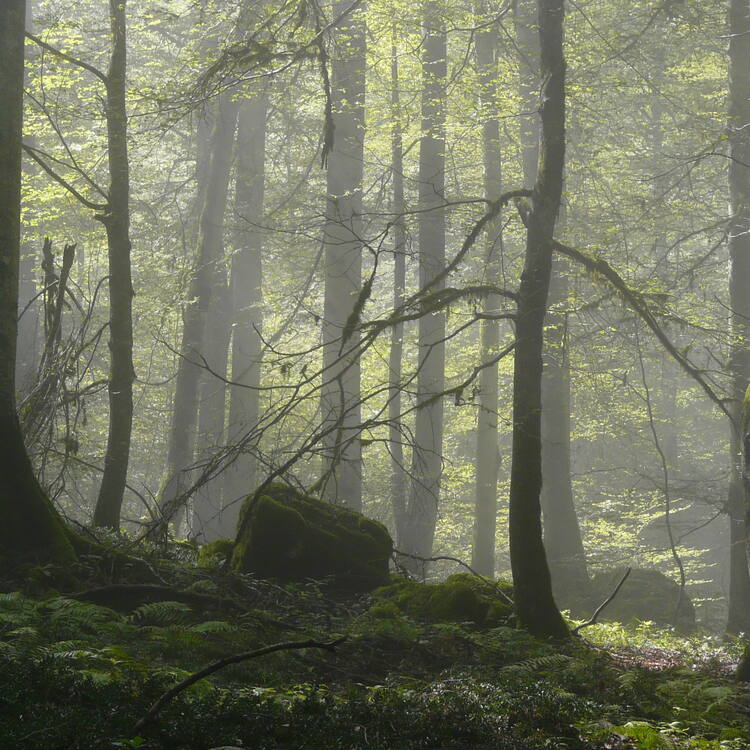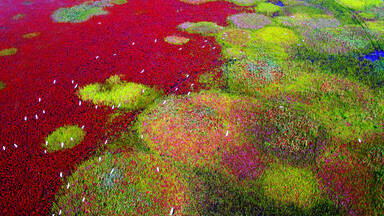Hyrcanian Forests
Hyrcanian Forests
The Hyrcanian Forests form a unique forested massif that stretches along the Caspian Sea in Azerbaijan and Iran. The history of these broad-leaved forests dates back 25 to 50 million years, when they covered most of this Northern Temperate region. Their floristic biodiversity is remarkable with over 3,200 vascular plant species documented. To date, 180 species of birds typical of broad-leaved temperate forests and 58 mammal species have been recorded. Elements of the property comprise full ecosystems including top predators such as leopard, wolf and brown bear, and the forest has a high degree of rare and endemic tree species. The oldest trees seen here are 300-400 years old, with some possibly up to 500 years old.
Description is available under license CC-BY-SA IGO 3.0
Forêts hyrcaniennes
Les forêts hyrcaniennes forment un massif forestier unique qui s'étend le long de la mer Caspienne en Azerbaïdjan et en Iran. L'histoire de ces forêts de feuillus remonte à 25 à 50 millions d'années, époque à laquelle elles couvraient la majeure partie de cette région tempérée du Nord. Leur biodiversité floristique est remarquable, avec plus de 3 200 espèces de plantes vasculaires documentées. À ce jour, 180 espèces d'oiseaux typiques des forêts tempérées à feuilles larges et 58 espèces de mammifères ont été recensées. Les éléments du bien comprennent des écosystèmes complets, y compris les principaux prédateurs tels que le léopard, le loup et l'ours brun, et la forêt compte un grand nombre d'espèces d'arbres rares et endémiques. Les arbres les plus anciens vus ici ont entre 300 et 400 ans, certains pouvant même avoir jusqu'à 500 ans.
Description is available under license CC-BY-SA IGO 3.0
غابات هيركاني
تحتوي الأجزاء المكونة الجديدة، وادي دانغيباند و إستسوتشي (أذربيجان)، على غابات قديمة بالغة القيمة تنتمي إلى غابات الهيركان، وتؤدي هذه الأجزاء دوراً تكميلياً مع الأجزاء المكونة المدرجة بالفعل في إيران. تنتمي هذه الأجزاء إلى نفس قوس الغابة الممتد على طول بحر قزوين. تشكل غابات الهيركان كتلة حرجية فريدة من نوعها تمتد على طول الساحل الجنوبي لبحر قزوين، ويعود تاريخها من 25 إلى 50 مليون سنة. تشتمل العناصر المدرجة حديثًا على نظم بيئية كاملة بما في ذلك الحيوانات المفترسة العليا مثل النمر والذئب والدب البني، وتحتوي الغابة على درجة عالية من أنواع الأشجار النادرة والمتوطنة. يتراوح عمر أقدم الأشجار في الموقع بين 300 و 400 عام، وقد يصل عمر بعضها إلى 500 عام.
source: UNESCO/CPE
Description is available under license CC-BY-SA IGO 3.0
希尔卡尼亚森林
新增的丹加班德和伊斯蒂苏奇山谷(阿塞拜疆)都属于极具价值的希尔卡尼亚古森林的分布区,它们的加入使原世界遗产更为完整。遗产的新老部分位于里海南岸的同一片林带。希尔卡尼亚森林是一片独特的森林集群,沿着里海南岸延伸,其历史可追溯到2500万至5000万年前。新增部分含有完整的生态系统,包括豹、狼、棕熊等顶级掠食者。此外这里拥有大量珍稀和特有树种。最古老的树木树龄有300-400年,其中一些可能达到500年。
source: UNESCO/CPE
Description is available under license CC-BY-SA IGO 3.0
Гирканские леса
Новые участки Дангябанд и Истисучайская долина (Азербайджан) включают в себя высокоценные древние леса, относящиеся к Гирканским лесам, и дополняют уже включенные участки в Иране. Они относятся к одной лесной полосе, протянувшейся вдоль Каспийского моря. Гирканские леса образуют уникальный лесной массив, протянувшийся вдоль южного побережья Каспийского моря, история которого насчитывает от 25 до 50 млн. лет. Новые элементы лесного массива представляют собой полноценные экосистемы, включающие таких крупных хищников, как леопард, волк и бурый медведь, а также леса с высоким содержанием редких и эндемичных видов деревьев. Возраст самых старых деревьев достигает 300-400 лет, а некоторых, возможно, и 500 лет.
source: UNESCO/CPE
Description is available under license CC-BY-SA IGO 3.0
Bosques hircanianos
Las nuevas zonas que se han incorporado al sitio, Dangyaband y el valle de İstisuchay (Azerbaiyán), contienen bosques antiguos de gran valor pertenecientes a los bosques hircanianos y complementan las áreas de Iránque ya estaban inscritas. Pertenecen al mismo arco forestal que se extiende a lo largo del mar Caspio. Los bosques hircanianos forman un macizo boscoso único que se extiende a lo largo de la costa meridional del mar Caspio, con una historia que se remonta a entre 25 y 50 millones de años. Los elementos que han sido recientemente inscritos comprenden ecosistemas completos que incluyen depredadores superiores como el leopardo, el lobo y el oso pardo, y el bosque presenta una gran cantidad/proporción alta de especies arbóreas raras y endémicas. Los árboles más viejos del sitio tienen entre 300 y 400 años, y algunos, posiblemente, incluso 500.
source: UNESCO/CPE
Description is available under license CC-BY-SA IGO 3.0
Outstanding Universal Value
Brief synthesis
The Hyrcanian Forests form a green arc of forest, separated from the Caucasus to the west and from semi-desert areas to the east: a unique forested massif that extends from south-eastern Azerbaijan eastwards to the Golestan Province, in Iran. The Hyrcanian Forests World Heritage property is situated in Azerbaijan and Iran, within the Caspian Hyrcanian mixed forests ecoregion. It stretches approximately one thousand kilometres along the southern and south-western coast of the Caspian Sea and covers around 7% of the remaining Hyrcanian forests in Iran.
The property is a serial site with 17 component parts shared across three Provinces (Gilan, Mazandaran and Golestan) in Iran and across two Districts (Lenkoran and Astara) in Azerbaijan and represents examples of the various stages and features of Hyrcanian forest ecosystems. Most of the ecological characteristics of the Caspian Hyrcanian mixed forests are represented in the property. A considerable part of the property is in inaccessible steep terrain. The property contains exceptional and ancient broad-leaved forests which were formerly much more extensive however, retreated during periods of glaciation and later expanded under milder climatic conditions. Due to this isolation, the property hosts many relict, endangered, and regionally and locally endemic species of flora, contributing to the high ecological value of the property and the Hyrcanian region in general.
Criterion (ix): The property represents a remarkable series of sites conserving the natural forest ecosystems of the Hyrcanian region. Its component parts contain exceptional broad-leaved forests with a history dating back 25 - 50 million years ago, when such forests covered most parts of the Northern Temperate region. These huge ancient forest areas retreated during Quaternary glaciations and later, during milder climate periods, expanded again from these refugia. The property covers most environmental features and ecological values of the Hyrcanian region and represents the most important and key environmental processes illustrating the genesis of those forests, including succession, evolution and speciation.
The floristic biodiversity of the Hyrcanian region is remarkable at the global level with over 3,200 vascular plants documented. Due to its isolation, the property hosts many relict, endangered, and regionally and locally endemic plant species, contributing to the ecological significance of the property, and the Hyrcanian region in general. Approximately 280 taxa are endemic and sub-endemic for the Hyrcanian region and about 500 plant species are Iranian endemics.
The ecosystems of the property support populations of many forest birds and mammals of the Hyrcanian region which are significant on national, regional and global scales. To date, 180 species of birds typical of broad-leaved temperate forests have been recorded in the Hyrcanian region including Steppe Eagle, European Turtle Dove, Eastern Imperial Eagle, European Roller, Semicollared Flycatcher and Caspian Tit. Some 58 mammal species have been recorded across the region, including the iconic Persian Leopard and the threatened Wild Goat.
Integrity
The component parts of the property are functionally linked through the shared evolutionary history of the Caspian Hyrcanian mixed forest ecoregion and most have good ecological connectivity through the almost continuous forest belt in the whole Hyrcanian forest region. Khoshk-e-Daran, is the only component part that is isolated, however it still benefits from a high level of intactness and contributes to the overall value of the series. Each component part contributes distinctively to the property’s Outstanding Universal Value and the component parts together sustain the long-term viability of the key species and ecosystems represented across the Hyrcanian region, as well as the evolutionary processes which continue to shape these forests over time.
Several component parts have suffered in the past from lack of legal protection, and continue to be negatively impacted to some extent by seasonal grazing and wood collection. The sustainable management of these uses is a critical issue for the long-term preservation of the property’s integrity and it will require strong ongoing attention by the States Parties.
Protection and management requirements
All component parts of the property are state owned and strictly protected by the respective national legislation in Azerbaijan and Iran. The two component parts in Azerbaijan are located within the boundaries of Hirkan National Park under the responsibility of the Ministry of Ecology and Natural Resources, and are subject to a strict protection regime. The 15 component parts in Iran are protected through the Nature Conservation Law and by the Heritage Law. It will be important to harmonize and streamline the management and protection regime across the transnational property as a whole.
The management of the property’s component parts in Azerbaijan is subject to the Management Plan of Hirkan National Park. The management is ensured by around 100 staff. The national park authority manages the component parts and their buffer zone in cooperation with local stakeholders, especially the Talish people living within the national park. The Talish people follow close to sustainable livelihoods, which has contributed to secure the preservation of the valuable forest until the present time. They have traditional rights to use the land within the buffer zone of the national park.
The management of the property’s component parts in Iran is under the responsibility of three national agencies, the Iranian Forests, Range, Watershed and Management Organization (FRWO), Department of Environment (DoE) and the Cultural Heritage, Handicrafts and Tourism Organization (ICHHTO). A National Steering Committee is in place to ensure coordination across the series as a whole. This mechanism will need to be maintained in order to guarantee comprehensive management of the property into the future, based on a common vision and supported by adequate funding. Each component part has a management plan however, a transnational “Master Management Plan” for the whole property is also a long-term requirement. The national and component-specific plans should be maintained, developed and updated regularly together by the responsible management institutions, in cooperation with ministries, universities and NGOs across both States Parties.
Public access and use of the area is legally regulated and logging, grazing, hunting and most other uses that may potentially impact the property are strictly prohibited within all component parts. Vehicle access and other uses and activities that may potentially impact the property are also either forbidden or strictly regulated. However, enforcement of access and use regulations is not always effective and requires strengthening. Particular attention is required to maintain and enhance where possible, ecological connectivity between component parts and to ensure effective regulation of seasonal grazing and wood collection, in consultation with local communities.


